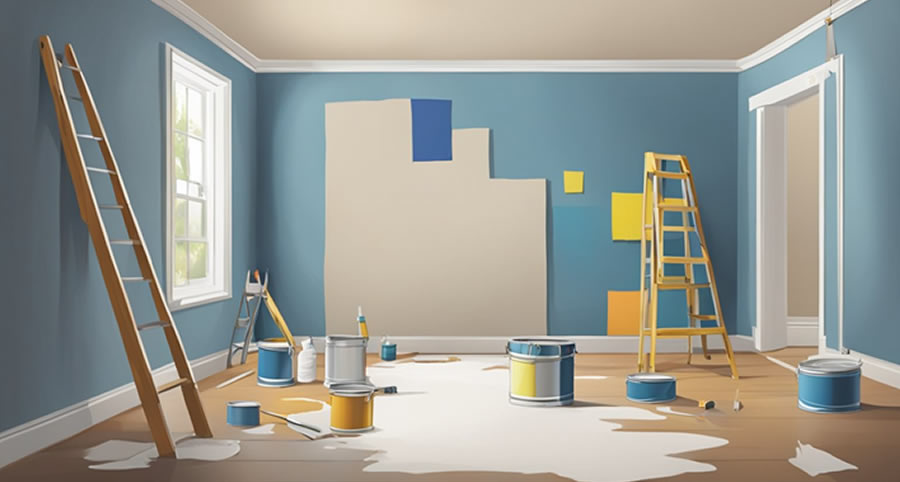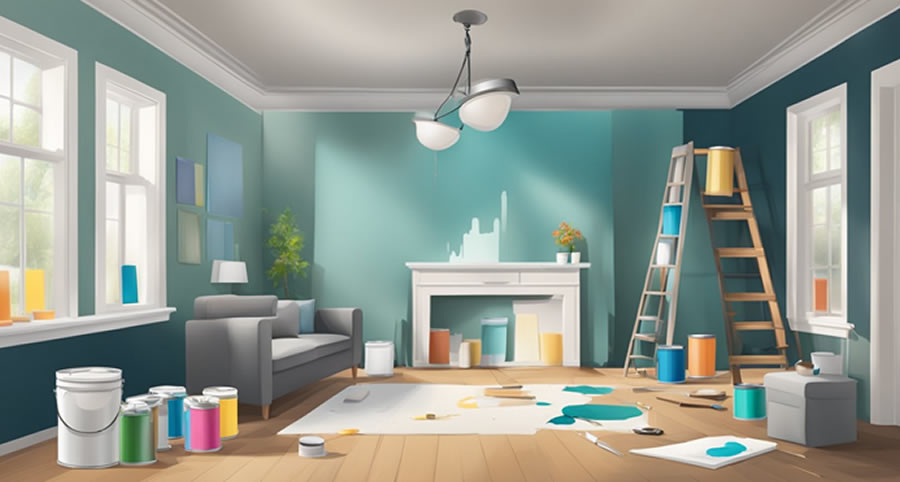Redecorating a home can significantly enhance its ambience and value. One of the most effective ways to achieve a fresh look is through residential interior painting.
I understand the transformative power of a new coat of paint, whether it’s to brighten up a living room or add a touch of elegance to a bedroom. As a residential painter myself, it’s rewarding to see the transformation that comes with meticulously applying the perfect shade to a client’s walls.
The journey of revamping your home’s interior requires careful planning and attention to detail. I always advise choosing quality materials and paints for a long-lasting finish that will stand the test of time.
The painting process itself should be carried out with precision and care, ensuring not just an impeccable finish but also the safety of your home and belongings.
While I tackle the technical aspects of painting, I also help in protecting furniture and floors, and ensuring a clean workspace throughout the project.
Key Takeaways
- Redecorating with residential interior painting is a powerful way to enhance a home’s feel.
- Quality materials and precise application are crucial for lasting results.
- Professional residential painters provide meticulous care to home and safety during the project.
Planning Your Residential Interior Painting Project
When I’m gearing up for a new interior painting project, I find that two key steps will often dictate the success of the transformation: the excitement of choosing the perfect colour scheme and the critical importance of thorough surface preparation.
Choosing the Right Colour Scheme
Selecting the right colours for the interior of my home is quite thrilling yet pivotal. Consulting with a colour consultant can provide professional advice, ensuring the hues match both my personal style and the home’s lighting.
I’ve learned to consider factors such as the orientation of the room, natural light sources, and my lifestyle, which all influence the final appearance of the paint.
Tips for Colour Selection:
- Consider lighting: Daylight shows the truest colour, incandescent lighting brings out warm tones, and fluorescent lighting casts a sharp blue tone.
- Lifestyle reflection: The colours should reflect not just my taste but also align with the function of the space; vibrant for active areas and muted tones for restful spots.
Importance of Surface Preparation
Before any paint touches a wall, surface preparation is key. This includes cleaning surfaces, repairing any damage, sanding uneven areas, and applying primer.
Proper preparation ensures the best adhesion of paint and a flawless finish. As part of the preparation, I ensure to protect furniture and floors with drop cloths and secure any hardware or light fixtures.
Missing this step could lead to short-term aesthetics and long-term issues like paint peeling or cracking.
Checklist for Surface Prep:
- Repair any holes or imperfections
- Sand to a smooth finish
- Clean walls thoroughly
- Apply a suitable primer
Selecting Quality Materials and Paints
When I tackle a painting project, I ensure that I use the highest quality materials and paints available. This not only guarantees a stunning finish but also longevity and sustainability for my home’s interior.
Understanding Paint Finishes
In my experience, the finish of the paint plays a colossal role in both the aesthetics and practicality of the project. Here’s a breakdown:
- Matte: Ideal for low-traffic areas; hides imperfections but less durable.
- Eggshell: Slightly more lustrous than matte; good for moderate-traffic.
- Satin: It has a velvety sheen and stands up well to cleaning, suitable for busier areas.
- Semi-Gloss: Reflective and durable; excellent for trim and moulding.
- Gloss: Highly durable and easy to clean; best used sparingly on details.
I tend to choose Dulux paints for their reputation for a quality finish and extensive range of finish options.
Eco-Friendly and Health Options
Choosing eco-friendly and low-VOC (volatile organic compounds) options is important to me for both environmental and health reasons. Here are the specifics:
- Eco-Friendly: Look for paints with low or zero VOCs; these are better for the environment and the air quality inside my home.
- Health: VOCs can contribute to health problems; selecting a paint like Dulux’s eco range can mitigate these risks.
The Painting Process

When it comes to painting my house, I understand that meticulous surface prep and the right tools are essential for achieving long-lasting results.
The Role of Professional Painters
I’ve learned that professional painters are more than just experts with a brush. They bring a keen attention to detail to every job.
From the initial consultation right through to the final touches, house painters offer a workmanship guarantee that gives me the confidence that the paint job will stand the test of time.
- Surface Prep: They make sure to clean, sand, and patch surfaces to ensure that the paint adheres well and looks smooth.
- Undercoat: A quality undercoat is a foundation for a durable finish.
- Tools: They use high-quality brushes, rollers, and other equipment to get the job done efficiently.
Paint Application Techniques
Exploration into paint application techniques made it clear why the pros have such stellar results:
- Ceiling First: They begin with the ceiling, which is logical since any paint splatters can be handled later when doing the walls.
- Walls: Brushes are used to cut in around edges, and rollers are applied to fill in the broad surfaces.
- Trim: They apply paint to trim and baseboards with precision, ensuring a crisp, clean look.
Protecting Your Home and Ensuring Safety
When I take on a painting project, I’m not just focused on applying a fresh coat of paint. I prioritise safeguarding your home and everyone in it through rigorous adherence to health and safety protocols and proper insurance.
Insurance and Licenses
I am fully insured, holding both public liability and workers’ compensation insurance for peace of mind. It’s crucial to have these protections in place to cover any unexpected events.
I make sure that my trade licenses are current and sourced through reputable Australian bodies. This means I’m a licensed professional adhering to the strict standards required by our industry, reflecting the expertise of master painters.
Health and Safety Protocols
In every job I do, health and safety are my top priorities. Before picking up a brush, I ensure all personal protective equipment (PPE) is on hand and the area is secure, minimising risks to my clients and myself.
For every room I work in, I take the utmost care to protect your belongings and ensure thorough ventilation to manage paint fumes.
Additional Painting Services
When it comes to enhancing your home’s curb appeal and protecting it from the elements, I offer a wide array of painting services. Let’s take a closer look at the exterior painting options and special treatments I can provide for your house.
Exterior Residential Painting
Exterior of your home is just as important as the interior. That’s why I provide comprehensive exterior house painting services that cover every facet of your home’s facade.
Whether it’s weatherboard, brick, or render, I’ve got the expertise to apply the perfect coat of paint. Additionally, if you’re looking to rejuvenate your home, roof painting is another service I offer, using premium paints designed to withstand the harsh Australian climate.
Special Finishes and Treatments
Inside the home, you might be looking to create a feature wall with a bit more personality. That's where special finishes come into play.
I can apply a variety of techniques, like sponging, colour washing, and faux finishes, to add character to any room. These artistic touches can transform an ordinary wall into a focal point of your home.
Frequently Asked Questions
In this section, I've gathered the most common inquiries homeowners have when it comes to interior painting. These questions will help you understand key aspects of choosing finishes, estimated timelines, cost considerations, selecting a painter, choosing colours, and room preparation.
How do you determine the most suitable paint finish for each room in the house?
When deciding on the most suitable paint finish for each room, I consider the room’s function and the durability required.
Kitchens and bathrooms benefit from semi-gloss or gloss finishes due to their moisture resistance. Meanwhile, living rooms often look better with a matte or eggshell finish for a softer appearance.
Could you tell me about the typical duration needed to repaint a four-bedroom home?
The duration to repaint a four-bedroom home depends on the project's complexity and the home's condition but typically takes about a week.
This can vary based on the quality of existing paint, repairs needed, and how quickly the paint dries in current weather conditions.
What factors contribute to the cost variance when quoting an interior painting project?
Several factors contribute to the cost variance in an interior painting quote.
These factors include the size of the area to be painted, the type and quality of paint used, the level of detail work required, and the condition of the walls which may need preparation before painting.
What are the essential qualities to look for when choosing a professional painter for my home?
When I'm on the hunt for a professional painter, I value experience, licensing, insurance, and a strong portfolio of previous work.
It's also crucial they communicate effectively and understand my vision for the project.
Can you offer guidance on selecting the right colour palette for my home's interior?
Selecting the right colour palette for your home's interior requires considering the lighting, the room's size, and your decor.
Natural light can alter how a colour looks. I always recommend testing colour samples on your walls to see how they change throughout the day.
What steps should be taken to prepare a room before the painting crew arrives?
To prepare a room, I ensure all furniture is moved or covered. Then, I remove the decor and take off the electrical outlet covers. It's also important to clean the walls to remove any dust or grime. This provides a smooth canvas for the painters.

